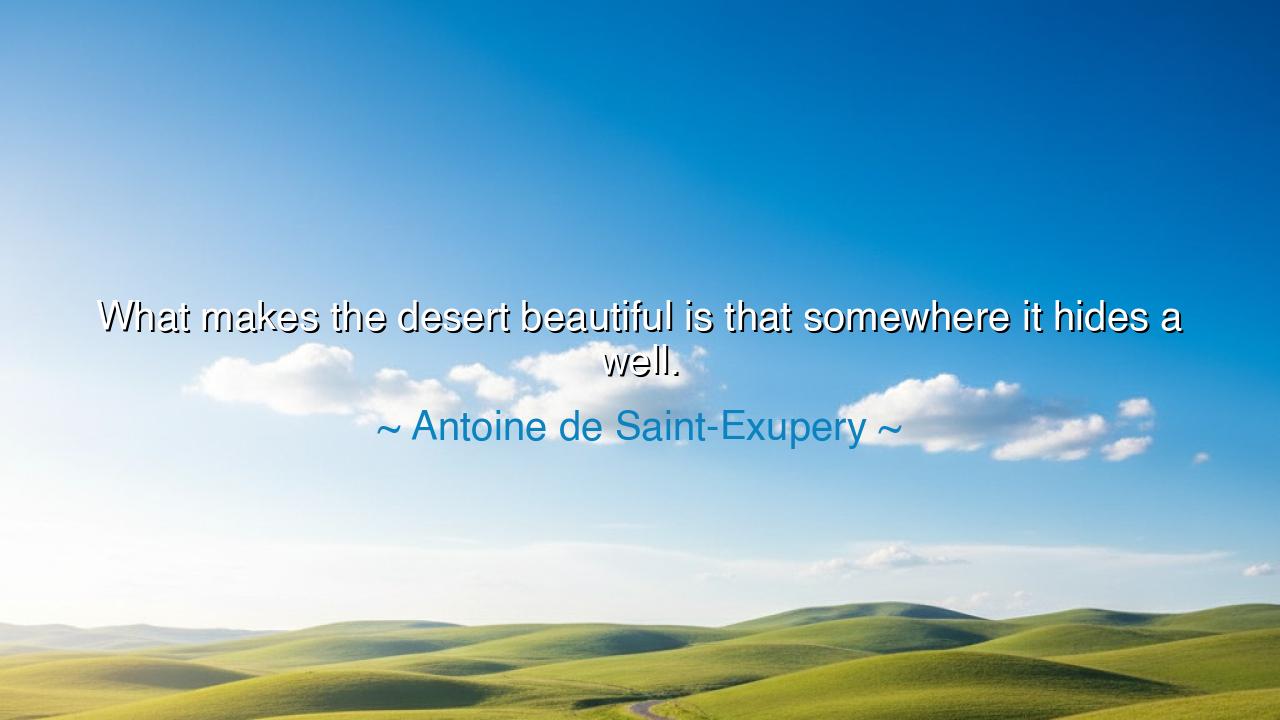
What makes the desert beautiful is that somewhere it hides a






“What makes the desert beautiful is that somewhere it hides a well.”
Thus wrote Antoine de Saint-Exupéry, the aviator-poet, philosopher of solitude, and author of The Little Prince. In this delicate yet profound saying, he speaks not only of the literal desert, but of the desert within the human soul — the barren places of life, where hope seems lost and beauty seems absent. Yet even there, he reminds us, something precious lies hidden: a well, a source of life, meaning, and renewal. It is the unseen promise that gives even emptiness its purpose, even suffering its depth. The desert is not beautiful because it is vast or silent, but because, beneath its harshness, it conceals hope.
Saint-Exupéry was a man who knew the desert well. As a pioneering aviator in the early twentieth century, he crossed the endless sands of North Africa, often alone, often at the mercy of the elements. In 1935, he crashed his plane in the Libyan desert and wandered for days without food or water, facing death beneath the pitiless sun. Out of that ordeal came not despair, but revelation — the realization that even in desolation, the heart of life endures. The desert became to him a mirror of the human condition: vast, perilous, but alive with hidden grace. When he wrote that “somewhere it hides a well,” he was recalling that miraculous truth — that in every wilderness, visible or unseen, there lies the possibility of salvation.
The well is the eternal symbol of the soul’s sustenance. In the scriptures and stories of old, the well is where truth and revelation dwell — a source of living water, guarded by silence. It cannot be seen from afar; it must be sought, often through thirst and trial. Thus, the desert, in all its emptiness, becomes a place of awakening. The wanderer who endures its loneliness discovers what the comforted man never will — that true beauty is not in abundance, but in the hidden promise of renewal. The well does not change the desert’s nature, but it transforms the way we see it. For when the heart knows that something sacred is buried beneath hardship, it can bear any dryness with faith.
History, too, bears witness to this truth. Consider the life of Nelson Mandela, who spent twenty-seven years imprisoned on the barren island of Robben Island — a desert of stone and injustice. Many would have withered under such a fate, but Mandela found within that desolation a wellspring of strength and forgiveness. His cell became his desert; his heart, the well. From that inner source, he drew the waters of patience and compassion, and when he was finally freed, he poured that water over a nation divided by hate. His life teaches us, as Saint-Exupéry did, that beauty is not the absence of suffering, but the presence of meaning hidden within it.
To the eyes of the world, the desert appears lifeless — yet those who walk it with reverence know that it is alive with secrets. The same is true of the barren seasons of our own lives: the times of loss, of doubt, of silence. We see only the sand, the heat, the emptiness, and we despair. But the wise learn to trust the hidden well — the small, quiet truths that nourish the soul when all else fails. Sometimes it takes great stillness to hear the whisper of water beneath the ground. Sometimes it takes hardship to remind us of the depth of our own spirit.
The lesson, then, is this: never despise the desert. When your life feels dry, when your heart is weary, when purpose seems lost — remember that beneath the surface, something is waiting for you. Do not curse the emptiness; seek the well within it. Perhaps it is a lesson, a relationship, a moment of insight, or the rediscovery of faith. To find it, you must walk on, even when the horizon seems endless. The well does not reveal itself to those who turn back — only to those who persist with hope.
So, my child of wind and dust, take heart. The desert will not destroy you if you remember its secret. Within every trial lies a hidden blessing; within every silence, a voice; within every barren place, a well of life. Saint-Exupéry, who found both danger and wonder in the desert, teaches us that even when all seems lost, the soul’s thirst is never in vain. For beneath the sands of every hardship, there lies a spring eternal — waiting for those with courage to dig, and with faith to believe that what makes the desert beautiful is that somewhere, unseen, it still hides a well.






AAdministratorAdministrator
Welcome, honored guests. Please leave a comment, we will respond soon